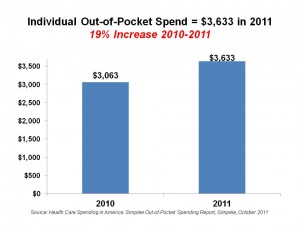 The Big Headline under the banner of Health Economics this week is the statistic that growth in U.S. national health spending slowed to an anemic 3.9% in 2010 — the slowest rate of growth in the 51-year history of keeping the National Health Expenditure Accounts.
The Big Headline under the banner of Health Economics this week is the statistic that growth in U.S. national health spending slowed to an anemic 3.9% in 2010 — the slowest rate of growth in the 51-year history of keeping the National Health Expenditure Accounts.The chart tells the story of another kind of health care cost inflation: that is the out-of-pocket cost increase for health consumers, in this case members of the Simplee database of people tracking their health spending. While this is not a random sample of U.S. adults, lifting the hood on Simplee’s database provides insights into how health-engaged people are responding to growing health care costs as a component of their household budgets.
As the chart shows, out-of-pocket spending for Simplee tool users grew nearly 20% between 2010 and 2011, to $3,633. Premiums in 2011 were $5,208, equal to $434 a month for Simplee families. This does not include employer contributions.
Simplee calculated the real value of that insurance payment to consumers, based on the negotiated discount received by Simplee consumers’ health plan sponsors. Instead of the $8,841 spent by families ($3,633 out-of-pocket + $5,208 premium), the total amount billed for health care services would have been $15,512. So Simplee users had a 43% effective discount on their health services in terms of amount billed versus amount spent.
Health Populi’s Hot Points: The Health Affairs article linked above details the National Health Expenditure history. The analysts talk about the spending slowdown in the context of the highest unemployment rate in 27 years, the erosion of private health insurance provision by employers and plan sponsors, employers’ caution about hiring new workers, and the lowest median household income since 1996.
That environmental context laid the table for consumer self-rationing in health services over the past few years, a trend tracked by the Kaiser Family Foundation Health Tracking Polls since 2009.
We health economists used to consider medical goods, like insulin and pacemakers, as having “inelastic demand:” that is, as prices would go up on these items, demand would still be there. It’s clear that for many people, tough decisions are being made regarding their willingness-to-pay for expensive cancer drugs on one end of the health continuum, to visits to doctors when “I feel sick” on the other less-acute end of the health-illness spectrum.
For health data geeks (like me and many of you readers), the Employee Benefit Research Institute published their Issue Brief of Health Savings Accounts for 2006-2011. The study found that U.S. health citizens continue to self-ration health care: 1 in 5 older Americans has cut back on health care to save money, in the form of postponing visits to doctors, cutting medication dosages (against physician prescriptions), and stopping pills altogether.
This trend is especially pronounced among women and African-Americans.
When we congratulate ourselves on “bending the health cost curve,” we’d best pay attention to what’s causing the bending. It’s not re-engineering the workflow of health care processes and changing the way we pay for care that’s inspiring the bending.




 Thank you, Jared Johnson, for including me on the list of the
Thank you, Jared Johnson, for including me on the list of the  I am so grateful to Tom Lawry for asking me to pen the foreword for his book, Health Care Nation,
I am so grateful to Tom Lawry for asking me to pen the foreword for his book, Health Care Nation,  Thanks to Feedspot for naming this blog, Health Populi, as a
Thanks to Feedspot for naming this blog, Health Populi, as a